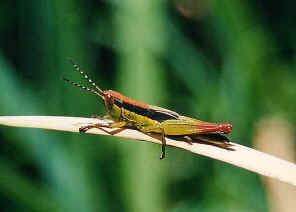Creek Grasshopper - Bermius odontocercus
Family Acrididae
This page contains pictures and information about the Creek Grasshoppers that we found in the Brisbane area, Queensland, Australia. They are also known as Eastern Toothed Bermius.

- Adult male and female, body length 35mm and 40mm
We easily found them along Bulimba Creek in Yugarapul Park and Wishart in Brisbane. They usually hide among those dense tall grasses and reeds just next to the creek. This grasshopper is common in Brisbane bushlands as long as there is flash water with reeds..
-



- Creek Grasshoppers are grass-green in colour with black strips on both sides of the body from eyes to wing tips. The top of the head and thorax is brown in colour. Both females and males are fully winged. They look the same and males are slightly smaller in size.



- There are a few species in the tribe Oxyinae which look very similar. They can be recognized by the shape of the male cercus. The cercus of Creek Grasshopper are internally toothed, i.e., the also known as Eastern Toothed Bermius. On photos we separated this species by their banded antenna and the spines on their keens.
-


- Nymph 20mm
- The nymphs and adult look similar except adults have fully developed wings.
-


- Nymph 20mm



- Nymph 15mm
- Those nymphs pictures were taken next to Bulimba Creek in Yugarapul Park.
-



- They feed on most kinds of grasses and sedges, as long as they grow near the water edge. Adults and nymphs can be found feeding on the same plants at the same time.



- Creek grasshoppers have a number of adaptations for their semiaquatic life style. The Grasshoppers feed on blade grass that grow near the water edge. They swim near the surface when jump into the water. They are different from other grasshoppers with their shiny and smooth surface. This feature could be an advantage when swimming in water.

- In a suitable habitats, i.e., dance grasses near water edge, large number of them can be found in a small area.



- In mid-summer, we found the nymphs and adults sun bathing on tall grasses along the water edge. When we came closer than two meters, they hided on the other side of the grasses. When we moved more closer, about one meter, nymphs quickly jumped and adults flied away.



- They are fast jumpers and good fliers.
-



-


- Reference:
- 1. Grasshopper Country - the Abundant Orthopteroid Insects of Australia, D Rentz, UNSW Press, 1996, p179.
- 2. A Guide to Australian Grasshoppers and Locusts - DCF Rentz, RC Lewis, YN Su and MS Upton, 2003, p65.
